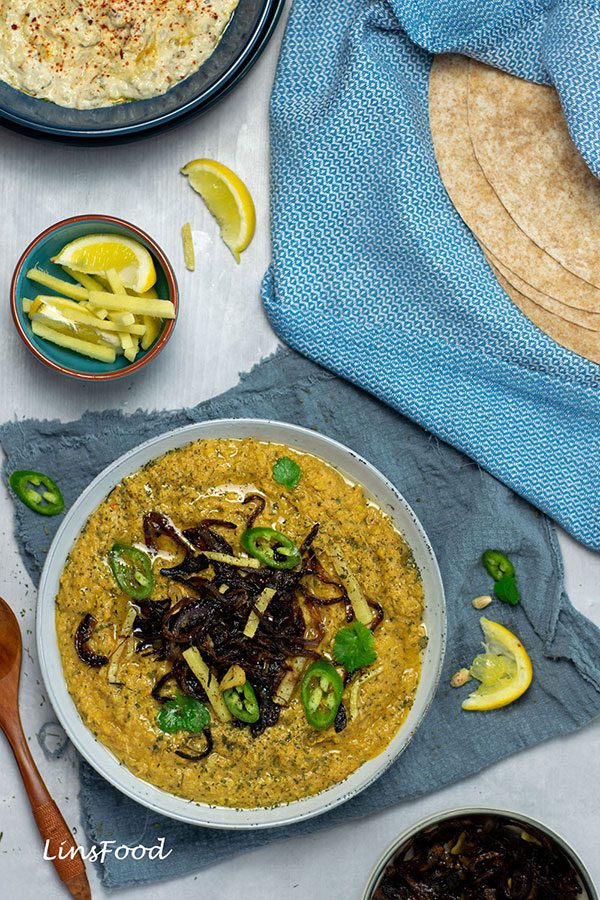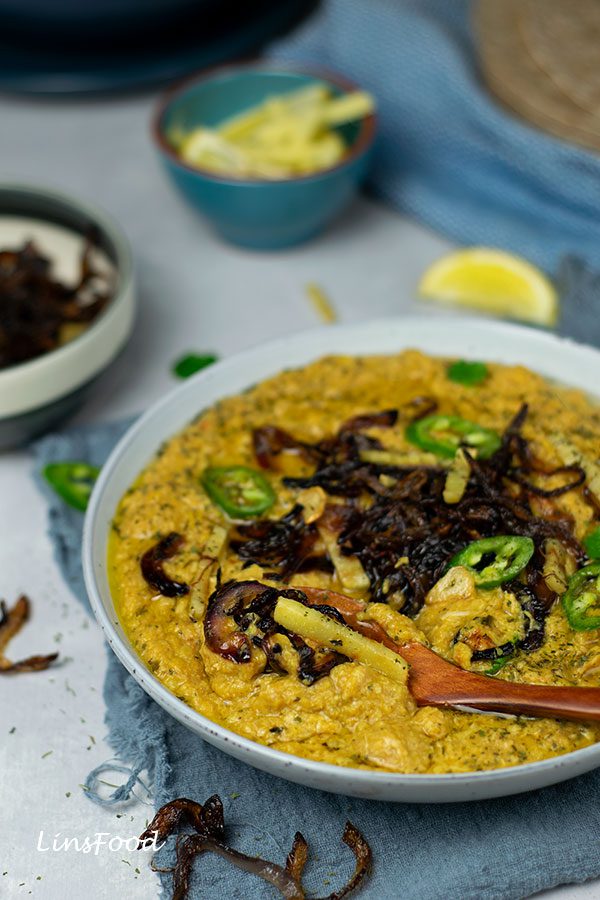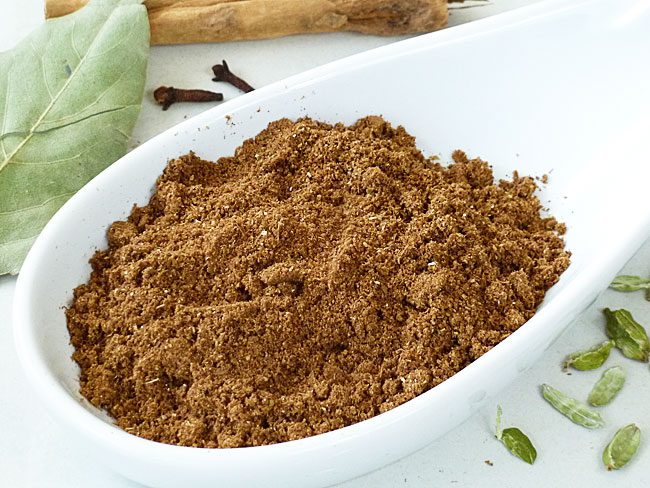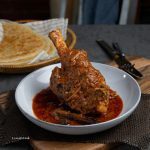Haleem is a thick, porridge-like stew that is high in protein, full of grains, is very filling and a must during the month of Ramadan in South Asia.
Estimated reading time: 8 minutes

Origin of Haleem
Haleem is said to owe its origin to an old Arabic dish called Harisa. The first written record of Harisa is found in a 13th century cookbook called Kitab al-Tabikh, written by al-Baghdadi, Muhammad, b. al Hasan.
- kitab = book
- tabikh = cooking
So, book of cooking, or book of dishes.
I own a translated version of this cookbook, and it’s truly a fascinating read, full of history and culture. Below, you can see the original Harisa recipe, as translated by Charles Perry, a food history scholar. Click here to get a copy of the book on Amazon (affiliate link).
The recipe made its way to India and made its in the southern state of Hyderabad, where it naturally absorbed the local spices. Today, when someone mentions this dish, you’ll often here it described as Hyderabadi Haleem.

Haleem Recipe
The traditional haleem is a fairly long and perhaps, painstaking affair, taking 6 – 8 hours to cook.
Haleem essentially contains 2 parts:
- meat
- grains
These 2 are traditionally cooked separately, then blended together to give an almost paste-like, porridge consistency.
The grains also require soaking overnight. But that is par for the course when cooking pulses and lentils, if you want to make them easier to digest.
In our recipe today, I’m giving you the method that we use when making haleem. We essentially cook the grains and the meat in one pot, before pulsing it to give a stew that isn’t fully blended but with the odd tiny piece of meat and grain.
To cook Haleem, we:
- Soak the grains overnight.
- Sauté the aromatics, add the ground spices, then the chicken and most of the grains and cook for 1 hour, until the chicken and grains are cooked and tender.
- Pulse with an immersion blender.
- Add the red split lentils and a little water, and cook for 20 minutes. You can skip this part if you add these lentils in step 2, above.
- Taste it to check seasoning, adding more salt if needed.
- Squeeze some lemon juice all over.
- Heat some oil and ghee and fry some onions until brown, add ginger and garlic slices for 30 seconds and pour this flavoured oil all over the finished haleem.
- Top with herbs, fresh ginger and sliced green chillies.
The full recipe is in the recipe card below.
Ingredients
As mentioned above, Haleem is a combination of grains and meat. While there are traditional choices, the type of grain and meat really does depend on what you like. Let’s take a brief look at the possibilities.
The Meat
In India, mutton would have been the meat of choice. But these days, you will find haleem cooked with chicken, beef or lamb.
In fact, during Ramadan, you will find even seafood haleem being offered in upmarket restaurants, and naturally vegetarian versions too.
If you are using red meat, the cooking time will be 2 – 2 1/2 hours, compared to the 1 hour for chicken, as we have here.
The Grains
Wheat or barley are the traditional choices here, with chana dal being a must for many. On top of that, you can also add another one or two types of lentil. What you use is completely up to you.
Using different kinds of dals or lentils gives your haleem a richer and more varied flavour. Here are some examples of lentils or dals that you can use to cook haleem, with the common English names in brackets.
- whole wheat
- barley (pot barley requires soaking, pearl barley doesn’t)
- chana dal (split Bengal gram, chickpea lentils)
- skinned and split moong dal (yellow moong dal, yellow dal)
- urad dal (skinned black gram)
- masoor dal (red split lentils)
- cooked rice added at the end – this is more common in Pakistan
To Soak or Not to Soak Lentils?
Lentils and mung beans don’t technically need to be soaked, unlike beans. However, soaking them has a few advantages. It softens the lentils and breathes life into them, the first step when you are sprouting seeds and such.
It also also cuts down on cooking time. And more importantly, soaking lentils allow us to digest them better.
This last reason is especially important if you have any bloating issues. There is a lot of science behind this, do a simple Google search to learn more.

What Grains am I using?
My suggestion would be to use at least 3 different types of grains. This is what I’m using in today’s recipe:
- barley (click to buy on Amazon)
- chana dal
- moong dal
- masoor dal
I’m using equal portions of the first 3, and a smaller portion of the red split lentils that I add after blending everything. I then cook everything for another 20 minutes, to allow the masoor dal to cook but still retain its shape.
This is because I am not a fan of a stodgy, smooth haleem. I much prefer it to have a little bit of whole pieces of lentils, as well as tiny shreds of meat. However, you can just add the red lentils at the start to cut down on cooking time, if you prefer.
In fact, when I make it with beef or lamb, I cook the meat separately, and shred the cooked meat with 2 forks instead of blending it.
You might want to give that a try and see which you prefer.

Haleem Masala
I’ve received many messages over the years asking about this, and the use of whole spices when cooking haleem.
Let’s address the whole spices first. This is a matter of preference. Because haleem is going to be blended before being served, I prefer to do without the whole spices, preferring to use ground spices instead, in the form of the masala.
Using garam masala or chaat masala in the recipe ensures that we are not missing out on any crucial whole spice.
So what is haleem masala? It really is just a combination of standard Indian and Pakistani spices that one uses to make curries.
So in the recipe card below, they are under the header “ground spices”. These are what we’ll be using:
- coriander
- cumin
- turmeric powder
- chilli powder (cayenne in the US)
- garam masala powder (any shop bought will do, but click here for homemade garam masala)
Topping and Garnish
The topping and garnish for Haleem is as important as the rest of the ingredients, so don’t skimp on it. Reduce the oil/ghee a little if you want, but be generous with everything else.
This is the traditional finish for haleem:
- fried onions
- fresh ginger
- sliced green chillies
- fresh coriander leaves (cilantro) and mint leaves
- fresh lemon juice and lemon wedges
- cashew nuts – whole or lightly crushed – I’m not using them
After frying the onions, we pour everything, including the fat all over the finished haleem. Because of that, I like to add a little more flavour to the oil/ghee mix by adding some ginger and garlic slices too, as you’ll see in the recipe below.


Make Ahead
Let me tell you, haleem tastes better the next day, like all curries and stews! So you can definitely make haleem ahead, but don’t garnish it until just before serving.
Any haleem can be stored in the refrigerator for up to 3 days and frozen for up to a month. When you are reheating it, you will need to add water to adjust the consistency, as lentils absorb water.
How to Serve Haleem
It can be eaten on its own, like a savoury porridge, very much like Bubur Lambuk, the savoury rice porridge synonymous with Ramadan, in Singapore and Malaysia. That recipe is on my other blog: Singaporean and Malaysian Recipes.
Have some roti on the side to scoop it up, which is a very traditional way of enjoying this Ramadan recipe.
You could also serve it as a side dish in a South Asian themed meal.
Last Word
Haleem is a very rustic affair. And can be made to suit your tastes. So use whatever grains and meat you like. And make it as thick or as runny as your tastes dictate.
Shall we get our aprons on?
If you enjoy the recipe, drop me a comment and let me know. And if you are feeling like a star, don’t forget that 5-star rating!
If you make this recipe, post it on Instagram and tag me @azlinbloor and hashtag it #linsfood.
Lin xx
More South Asian Recipes




Haleem Recipe with Chicken
Equipment
- bowls as needed for soaking grains
- Knife
- Chopping board
- large saucepan
- immersion blender stick
- frying pan
- ladle
- Spatula
Ingredients
- 2 Tbsp vegetable oil
- 1 Tbsp ghee
- 500 g boneless chicken thighs (or chicken breasts, I prefer the flavour of thighs)
- 750 ml water
- ½ Tbsp salt
- 2 Tbsp concentrated tomato paste
- 2 mild green chillies leave whole
Grains
- 100 g barley (or wheat) (pearl barley will not need soaking, pot barley does)
- 100 g chana dal (split Bengal gram, chickpea lentils)
- 100 g skinned and split mung dal (yellow dal)
- 50 g masoor dal red split lentils (don't need soaking)
Aromatics for Cooking the Haleem
- 1 large onion pre peeld weight about 200g/7 oz
- 4 medium cloves galic or 1 Tbsp garlic paste
- 5 cm thick piece of ginger or 1 Tbsp ginger paste (so 2 Tbsp garlic-ginger paste altogether, if that's what you use)
Dry Spices
- 1 Tbsp ground coriander
- 1 Tbsp mild chilli powder (cayenne powder in the US)
- ½ Tbsp ground cumin
- 1 tsp turmeric powder
- 1 Tbsp garam masala
Garnish and Topping
- 1 Tbsp vegetable oil
- 2 Tbsp ghee
- 1 large red onion
- 7.5 cm thick piece of ginger
- 1 medium clove garlic
- 5 stalks fresh coriander leaves (cilantro)
- 10 mint leaves
- 2 mild green chillies
- 2 Tbsp fresh lemon juice
- lemon wedges
Instructions
The Night Before (or at least 4 hours before)
- Soak the barley and channa and mung dals in room temperature water. I prefer to do this in separate bowls, but there is no reason not to soak them all in 1 bowl. Leave them on the kitchen counter, no need to cover.

Prep Work – Aromatics & Chicken
- Finely chop the onion.And grate, mince or pound your garlic and ginger, if not using a paste.

- Chop up your chicken into bitesize pieces.

Let's get Cooking
- Heat the oil and ghee in a large saucepan over medium heat and fry the onions for 2 minutes.

- Add the garlic and ginger and fry for 30 seconds.

- Add the dry spices, stir and add the chicken in. Stir to coat the chicken thoroughly.

- Add the grains and stir to mix.You can also add the masoor dal now, if you like, instead of after blending the haleem, as in step 7.

- Add the water, salt, concentrated tomato paste, and green chillies, stir well, and bring to a boil.Reduce the heat to low, cover and cook for 1 hour, until the chicken and grains are done.

- Using an immersion blender, pulse the cooked haleem a few times to mince the chicken and grains. Don't overdo this stage, you don't want to end up with a stodgy, rubbery mix. Blend to get a semi fine mix, with the odd tiny shredded chicken.You can blend the chillies or leave them whole.

- Now add the red lentil (masoor dal) and 60ml water (¼ cup) and bring it back to a simmer. Stir well and leave the dal to cook for 20 minutes.You can skip this step and add the masoor dal with the rest of the grains in step 4, if you prefer. It'll save you 20 minutes of cooking time.

Prep Work for Topping – Aromatics & Herbs
- While the red lentils are cooking let's prepare our topping. Halve the red onion, and thinly slice it.Slice the ginger into matchsticks.Slice the garlic widthwise.Finely chop the coriander leaves (cilantro) and mint.Slice the green chillies.

Back to the Haleem
- When the red lentils are done cooking, at about 20 minutes, check the seasoning and add more salt if necessary. You can also add more water if it's too thick for your taste.It's now ready to be served and you can either dish it up into your chosen serving dish or leave it in the saucepan as we get the garnish ready.Drizzle the lemon juice all over.Leave it to rest while you get the flavoured oil and aromatic topping ready.

Topping your Haleem
- Heat the oil and ghee in a frying pan on medium heat and fry the sliced onions for a good 3-5 minutes until they are brown and some of them will be crispy. Be careful not to burn them.Reduce the heat to medium-low if some are browning too quickly.

- When the onions are brown to your liking, add the garlic and ⅓ of the ginger sticks and stir for just 20 seconds – count to 20!

- Pour this flavoured fat all over the haleem, along with the onions, garlic and ginger.You can reserve some of the onions if you like, for diners to top up, if you don't fancy all of them on the haleem.Finish off with the chopped herbs, the rest of the ginger sticks, sliced green chillies and wedges of lemon, so diners can add more lemon juice, if they want.


Thank you for this recipe, it was amazing and we have leftover for tonight too. I love how you break yours down to easy to follow ingredients and steps.
My pleasure. I’m so pleased to hear that.